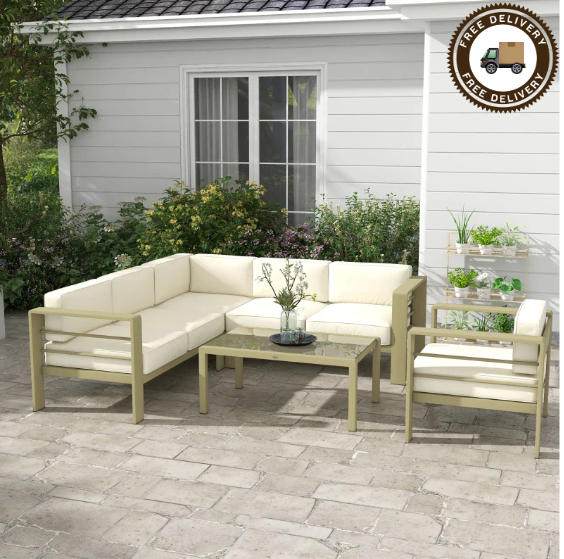Let’s face it, we all love the satisfaction when we fix things. So, when your rattan garden furniture is looking a bit worse for wear – and by a bit, we mean quite literally falling apart – something deep inside of you is probably screaming, "I can fix that."
If it’s not, then you’re probably just tempted to buy a whole new set. But we all know garden furniture doesn’t come cheap, so now is your chance to appease your inner voice and get your DIY on. Then the next time someone sits on your rattan corner sofa or eats at your picnic table, you can tell them that the repairs were all your own work. There’s no pride quite like it.
Maybe you’ve never fixed garden furniture before, or you don’t have much DIY experience under your toolbelt. Whatever the case, if you’re asking yourself, "Can I really repair garden furniture?" Rest assured, with a little help from this garden furniture repair guide, yes you can.
Before You Start
Before diving into repairs, it’s crucial to clean and assess your furniture. This step ensures that adhesives will stick properly and helps you understand the extent of the damage.
Cleaning Your Furniture- Remove dust, dirt, and debris.
- Use a soft-bristled brush to wipe away rust.
- Wash the entire item with mild detergent and water.
Assessing the Damage
- Identify common damage types such as cracks, holes, and tears.
- Determine which parts need repair and the steps required.
Key Takeaway: 🔧 Proper preparation, including cleaning and assessing your furniture, is essential for effective repairs and ensures adhesives bond well.
How to Repair Rattan Garden Furniture
Repairing rattan garden furniture might seem complicated, but it can be straightforward with the right tools and steps. Let’s dive into the repair process.
Tools and Materials Needed:
- Flathead screwdriver
- Scissors or pliers
- Glue suitable for outdoor use and rattan furniture
- Toothpick or a similar small tool (optional)
- Rattan strips
- Warm water
Step-by-Step Repair Process:
Tighten Loose Strands
- Use a flathead screwdriver to lift loose strands and pull them taut to eliminate gaps.
Cut Off Broken Strands
- Use scissors or pliers to cut off broken strands, reusing salvageable ones to prevent waste.
Soak New Rattan Strips
- Soak the strips in warm water for 30 minutes to an hour to make them pliable and easier to weave.
Gluing and Weaving
- Apply glue to the broken ends of rattan strands and press them back into place.
- Glue the ends of new rattan strips and weave them into the existing pattern using pliers and toothpicks if necessary.
Trim Any Excess
- Trim excess rattan strips for a neat finish, ensuring they match in length and are cut at an angle.
Tuck the Ends of Strips
- Tuck any loose strands behind existing ones and secure them with a bit of adhesive.
Alternative Repair Method with Epoxy:
- Apply epoxy to broken rattan strands and mold them into place following the manufacturer’s instructions.
Repairing Scratches on Rattan Furniture:
- Heat the scratched area with a hairdryer, sand and polish it, then apply varnish to prevent repeated damage.
How to Repair Wooden Garden Furniture
Wooden garden furniture undergoes significant stress due to changing weather conditions, leading to various types of damage. Here’s how to fix common issues.
Fixing Cracks and Holes:
Small Cracks
- Use wood putty or filler to repair small cracks.
Large Holes
- Patch larger holes with a new piece of wood, secured with wood glue or suitable adhesive.
- Seal and paint over the patched area once dry.
Tightening Loose Joints:
Identify Loose Joints
- Typically, loose joints are the result of a failing mortise and tenon joint.
Re-gluing Joints
- Tap the pieces apart with a rubber mallet.
- Remove old glue with a chisel and apply fresh glue generously.
- Rejoin the pieces, clamp them, and remove excess glue with a damp cloth.
Replacing Rotten and Broken Boards:
Remove Damaged Boards
- Identify and remove bolts or nails holding down the rotten boards.
- Use a rubber mallet, drill, and pry bar if necessary.
Install New Boards
- Measure and cut new boards to size.
- Align and space the boards evenly, securing them with bolts or screws.
- Sand and treat the wood for protection.
Key Takeaway: 🔧 Wooden garden furniture repairs involve filling cracks, re-gluing loose joints, and replacing rotten boards to restore functionality and appearance.
How to Repair Metal Garden Furniture
Metal garden furniture is durable, but it can still suffer from rust and cracks. Remember we can supply brand new metal sofas and sofa sets. Here’s how to make effective repairs.
Preparing for Repairs: Sand the area to remove rust and old paint, ensuring better adhesion for repair materials.
Using Epoxy for Small Repairs:
Mixing Epoxy
- Always follow the manufacturer’s guidelines to mix epoxy if required.
Applying Epoxy
- Apply epoxy generously to cracks and small holes.
- Let the epoxy cure completely before sanding and painting for a professional finish.
Finishing Touches:
- After the epoxy cures, sand the repaired area and apply a fresh coat of paint to match the rest of the furniture.
Key Takeaway: 🔧 Metal garden furniture can be effectively repaired with epoxy, ensuring durability and a smooth finish with proper sanding and painting.
Final Thoughts
So, you’ve fixed your garden furniture?
We’ll give you some time to rejoice. Whether you fixed a wobbly chair leg, replaced the boards of your picnic table, or patched up a hole in your metal furniture, hopefully you’ve appeased that inner voice.
Or maybe you’ve made it louder, and it’s now telling you to fix everything in sight – in which case, congratulations! You’re now a true DIYer with a beautiful set of garden furniture to show for it!
Since you’ve started, why not take a look at our and small garden ideas to give the rest of your garden some love? Y
ou can also explore our extensive collection of rattan chairs, rattan dining sets, and rattan bistro sets to further enhance your outdoor space.
By following these repair guides, you’ve not only saved money but also embraced the rewarding experience of DIY repairs.
Now, every time you enjoy your beautifully restored furniture, you can take pride in knowing that it’s the result of your hard work and dedication. Happy repairing!

